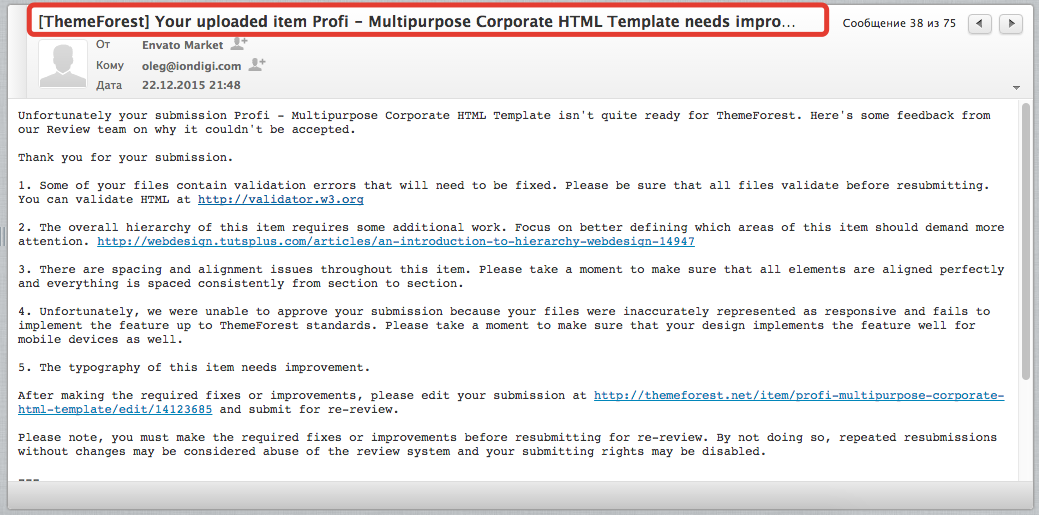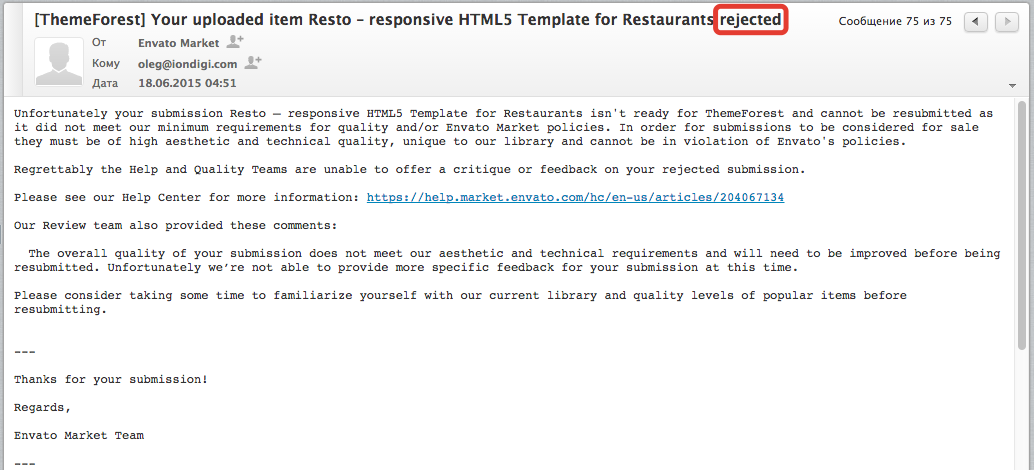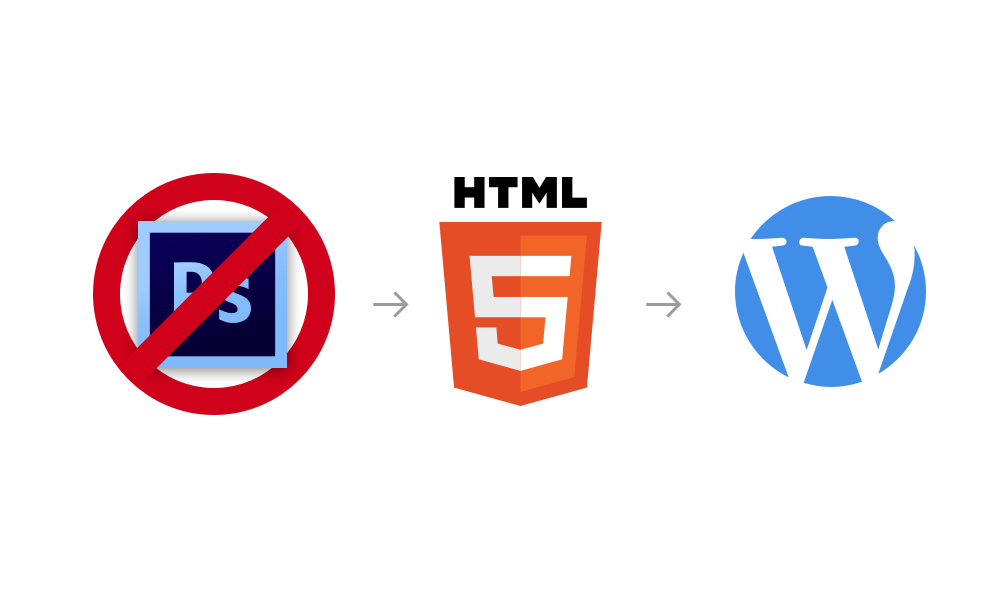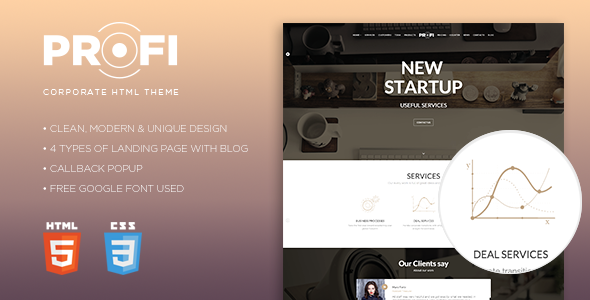Thorny road to sales on Themeforest.net - Part 1
Surely, many people think about trying to sell their templates on the well-known marketplace Envato.com , and some already successfully do it. In this article I want to share my experience in developing and selling templates on Themeforest.net
There is a lot of information on the cherished marketplace Envato.com in the network, but the detailed process of preparing projects comes across very rarely. I myself have repeatedly turned to successful authors selling on Themeforest.net for advice and help. Fortunately there are people willing to help for free. I hope my article will also be useful for beginning authors or those who are going to become an author. Or, at least, it will shed a little light on the production.

How it all began
As I told in my previous publications, for several years my small studio has been engaged in digital production: the development of web sites and mobile applications. And we started developing templates on the recommendation of my friend. Once he said that this is an excellent additional income for a small studio, and, they say, it takes very little effort for this. I liked the idea of having an extra income using a studio resource that is not loaded by current projects. But then I had no idea even how much time we would spend until the moment when our first template appeared on sale on Themeforest.net. It took us more than a year and a half to start sales. However, this is a special case and should not be guided by it. I know examples and more rapid success. But I want to tell you in more detail why we went to this for so long and what difficulties we encountered in the process.
')
Research and strategy development
As it should be, starting a new project, we proceeded to the survey. We studied all the categories of Themeforest.net. At that time, the Entertainment category and the subcategory Restaurant & Cafe seemed to us the most attractive. Relatively little competition with a fairly large number of sales.

As for the product itself, we focused on WordPress themes, since the earnings on WordPress templates are much more than on HTML and even more so PSD. Therefore, we decided to immediately concentrate our efforts on developing a WP template, rather than creating a site layout in Photoshop, although this is one of the necessary processes when creating a site. Also, we did not try to fill in the HTML template, despite the fact that the layout is also one of the stages. Although a lot of resources indicated that the PSD template installed is a green light for developing HTML, since the design issue is being removed, and after the layout, start developing the WordPress template. All the same, we were determined to begin selling our templates immediately with WordPress. Especially according to our data, which we drew from a variety of blogs on the development of templates, the category of PSD templates has a more rigid moderation. Moderators in this category increase the aesthetic requirements for the quality of templates almost daily.
If you decide to fill the template into this category, then look for inspiration on these resources:
- www.siteinspire.com
- flatinspire.com
- www.awwwards.com
- www.webdesign-inspiration.com
- www.thebestdesigns.com
- thedesigninspiration.com/category/websites
- onepagelove.com
We started drawing a template for restaurants, cafes and bars. The process looked as follows: we decided on the number of blocks required for this type of template, with the number of variations for each specific block.
- Main Page
- Blog:
- Left sidebar
- Without sidebar
- About us
- Dish fullpage
- Event:
- Events Fullpage
- Events List 2 Columns
- Events List 3 Columns
- Events List
- Menu:
- Menu 1
- Menu 2
- Menu 3
- Menu 4
- Menu 5
- Menu 6
- Contacts
- Dish Page
- Page 404
- Reservation
In our opinion, this should have been enough for an epruva. Later we planned to develop a theme and to finish drawing new and new pages. We drew the design rather quickly, in three or four weeks. One designer worked on the project, and we did the project in the background, since the main activity has always remained a priority. After that we started the layout, it took at the same labor costs (one performer) also three to four weeks. Further, a more complex and time-consuming process is the development of WordPress. Again, one developer, only this time the back-end, in his spare time, coped with the task in two or three months.
It's time for release. We prepared all the files according to the requirements of envato, at least we thought that we had prepared everything correctly. A review usually takes about 5-8 days. Often this is the case, but in our practice there have been cases when the inspection took more than two weeks.
Now nothing independent of us, it was necessary to pass moderation. As it turned out, it is quite difficult, especially for beginners. Below is an algorithm for the process of reviewing templates by Themeforest moderators.

We got a hard rejection.
What is Soft Rejection?
When you receive a Soft Rejected, this means that your product is almost ready for sale on the marketplace, but minor improvements are required. And the list of these improvements is described by paragraph in the letter or in the user’s panel in the Hidden Items section in the History section.

You just need to carefully read them and correct or modify your theme.
Soft Rejection Letter

What is Hard Rejection?
Hard Rejected is the rejection of your template without a description of the reason for that. But do not give up and keep improving. We received Hard Rejection dozens of times. And every time without explanation. Every time they thought “maybe, well, its this Themeforest,” but they took themselves in hand and continued to work.
Hard Rejection Letter

But in no case do not despair, everyone writes about it. Yes, of course, it is difficult to continue working on the template, if you have no idea what the problem may be.
In our experience, the reasons for hard redgets may be as follows:
- Your template does not meet the minimum aesthetic requirements of the marketplace or is not unique (for PSD, HTML, WordPress category templates)
- Problems with design of a different nature (for category templates PSD, HTML, WordPress):
- Uneven padding
- Not perfect typography. This is a fairly frequent problem that moderators always pay attention to. Attention to detail is the basic principle when creating a PSD template.
- Other
- No documentation or documentation of inappropriate quality. You can do the documentation manually, but it is better to use third-party services, such as documenter
- Problems with the code. This is a very extensive part, I will tell those moments that have arisen with our template. But in any case, validators should be used to verify the code:
- Use of unlicensed content. It is best to use free drains, but they must be listed in the template description and in the documentation.
- Using non-optimized images. Compresso Images
Throwing from side to side
After the first hard redget, there were five more. And we decided to try a step-by-step strategy: first, PSD, then HTML, and only then WordPress.

For all the time of our unsuccessful attempts with a template on a restaurant theme, it is morally obsolete. Therefore, we refreshed it a bit, looking at current trends. So that all our efforts with the first version of the template do not go unnoticed, we prepared a free PSD layout, called it with a different name and put it on Behance.net . And, indeed, he did not go unnoticed: he was in the selection of popular free templates on the resources Fusionplate.com and CSSauthor.com .
After that, we prepared an updated PSD file for download: organized layers, named each layer by its name. It must always be remembered that people will then use your template, and this is the basic principle that envato is guided by. Everything should be structured and very convenient.

But the attempt with the PSD layout was not successful than WP. A series of Hard Rejection and we are desperately shifting our efforts to the HTML template, they say, tough moderation in this category will not allow us to crawl through. But with HTML, we did not expect instant success: more than six Hard Rejection. And we make a knight's move, decide to switch to another subject and start from scratch.
After a year of unsuccessful attempts to fill in at least some item on themeforest, we start from the very beginning. This time we decided to get into the competitive category of Corporate. Only this time the solution is unequivocal - focus on the HTML version. Do not waste time on PSD, and WordPress to do only after HTML is uploaded.
After a year of attempts, this strategy seemed to us optimal.

The new template turned out strict and sustained. Exceptionally honed under the business theme.

But the revision of this HTML template took about 5 months and included 7 Hard and 8 Soft rejects. The first “software” can be considered a victory.

On Christmas, January 7, our HTML template finally got Approved.
On the first day of sales, I received about a dozen letters from different authors with the same content “we want to make a WordPress template based on your HTML”. This is the standard situation for most new templates. Many authors work according to this scheme - they make WP based on newly appeared HTML topics. Our template even got a mark for trends , but, unfortunately, after two weeks we lost it.
After reaching the first small goal of the HTML theme, we immediately began to develop the WordPress template. One back-end developer was still working on the project. To help him, he was a front-end developer who redesigned HTML quite strongly to be compatible with WP. Well, the designer on the pickup, because it was constantly necessary to cover some new elements that appeared with new WP widgets, such as blog elements, calendar, and so on.
After our account had already successfully sold a topic, each new product of ours received software reject from the first time. Perhaps we had gained experience and understood the requirements of themeforest, and maybe subjectively the best attitude of envato experts to selling authors than to beginners. A WP template based on an injected HTML template received software instantly, or rather, on the first attempt. And the check itself took 16 days! A field of this was followed by 6 software redgets with a ton of technical edits. Some of them concerned the layout and CSS, some said that it was necessary to cover the demo data of WordPress, but most of the edits were solely on the code.


It took us two and a half months to work on the WordPress template . Half of this time was spent waiting for responses from the reviewers. Of course, we did not sit in front of the monitor and did not wait, we worked on a new template. But you should always expect that a certain amount of time will be spent on the review. Planning deadlines, do not forget about it.

There is a lot of work on new templates ahead, plus additional tasks are added to promote and maintain sales of filled templates. But this is a separate topic for the article.
Source: https://habr.com/ru/post/278999/
All Articles